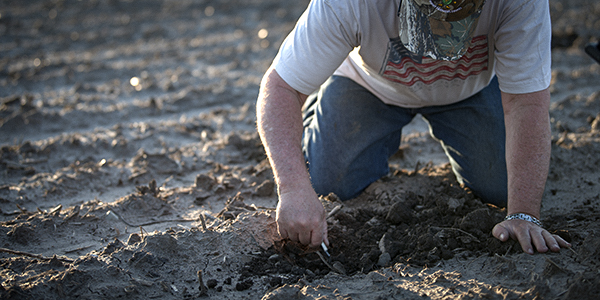AGRONOMICSUPPORT
YOU CAN TAKETO THE FIELD
Combating Soil Compaction
2019 was a challenging year for much of the Midwest, with some areas receiving over 200% more than their average precipitation. Combine that with a late fall and difficult field conditions during the growing season and harvest – there’s no doubt that a lot of us will be dealing with soil compaction.
Soil compaction occurs when soil particles are forced together, reducing the pore space between them and thus affecting water infiltration and drainage1. When field conditions are wetter than ideal, like we experienced last growing season and harvest, wheel traffic is the first and most likely cause. Heavy equipment driving the same tracks throughout the field can greatly increase the bulk density of the soil and thus increase the compacted areas.
This compaction can be detrimental to crop production because it restricts root growth, which then impacts the amount of water and nutrients that the plant can explore for and take up. A perfect example of this is the mohawking of roots from sidewall compaction that occurs during planting. Roots can’t penetrate the sidewall and will grow with the path of least resistance leading to a very elongated root system with little lateral branching that doesn’t explore the soil profile between the rows.
Because air space is reduced in compacted areas, the exchange of gasses is also reduced. This leads to slower aerobic activity in the soil, reduces overall microbial activity. With the reduction in microbial activity comes slower mineralization rates and ability for the soil to release nutrients.
So, how can we combat soil compaction? First, and this is the most common-sense approach, stay off the field until it is fit to work1. This was the biggest dilemma we faced in 2019 because most of the field operations needed to be completed when the soils were oversaturated and it wasn’t fit to be in the field. Other ways of reducing soil compaction include: Reduce tillage by only doing what is necessary, improve soil organic matter to increase pore space, reduce wheel traffic throughout the field and properly check tire pressure, just to name a few2.
One myth we should correct is that freeze-thaw cycles will reduce soil compaction caused by machinery. This is false because only the top two to five inches of soil experience more than one cycle per year, so only that layer of soil can be impacted1. Because of this, we’ll see areas this growing season that are negatively affected by soil compaction, as we most certainly have compaction layers deeper than 5 inches after a year like 2019.
For more information regarding soil compaction, check out these resources:
- https://extension.umn.edu/soil-management-and-health/soil-compaction
- https://extension.sdstate.edu/sites/default/files/2019-09/S-0003-14-Corn.pdf






Technical Team Agronomist